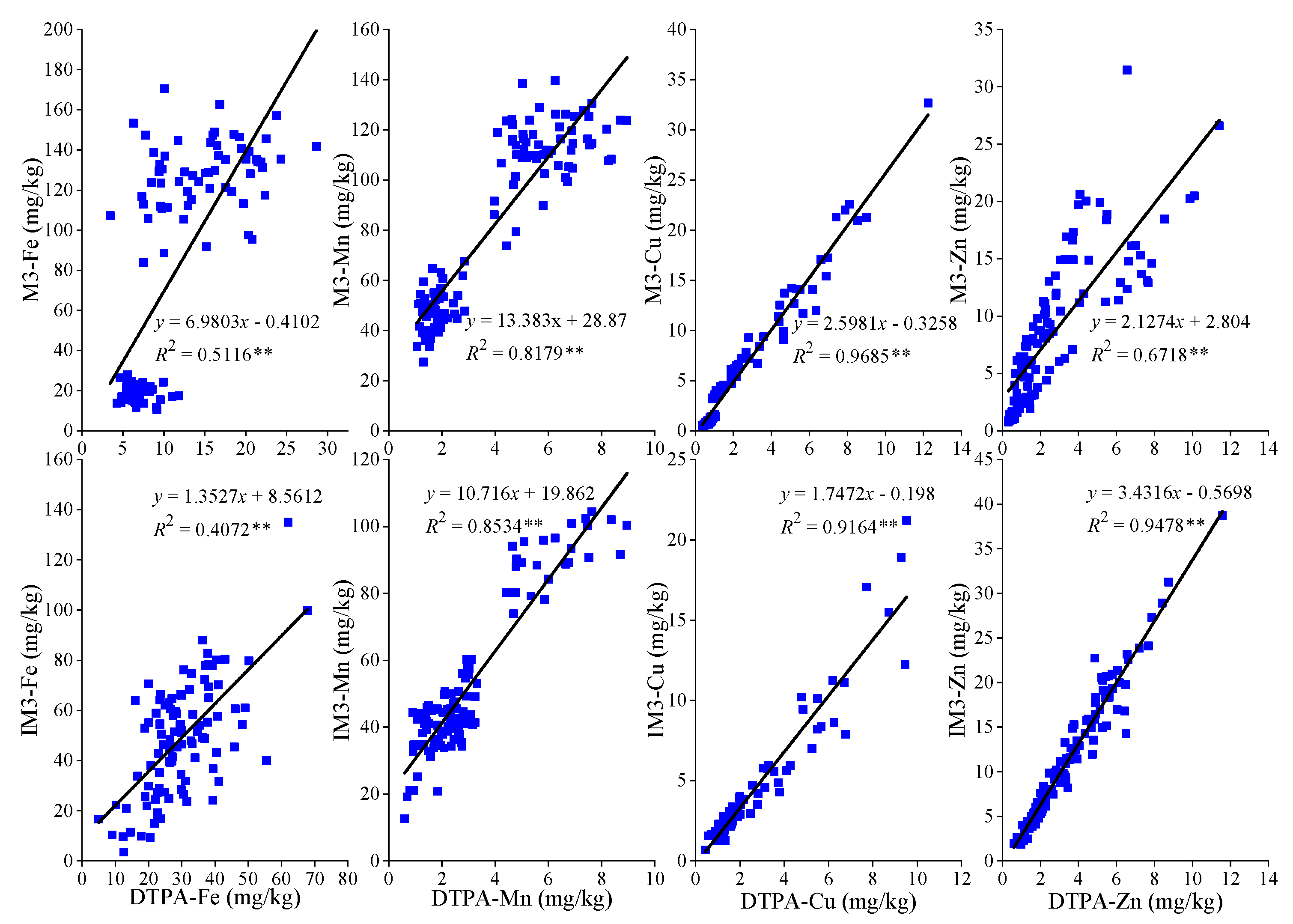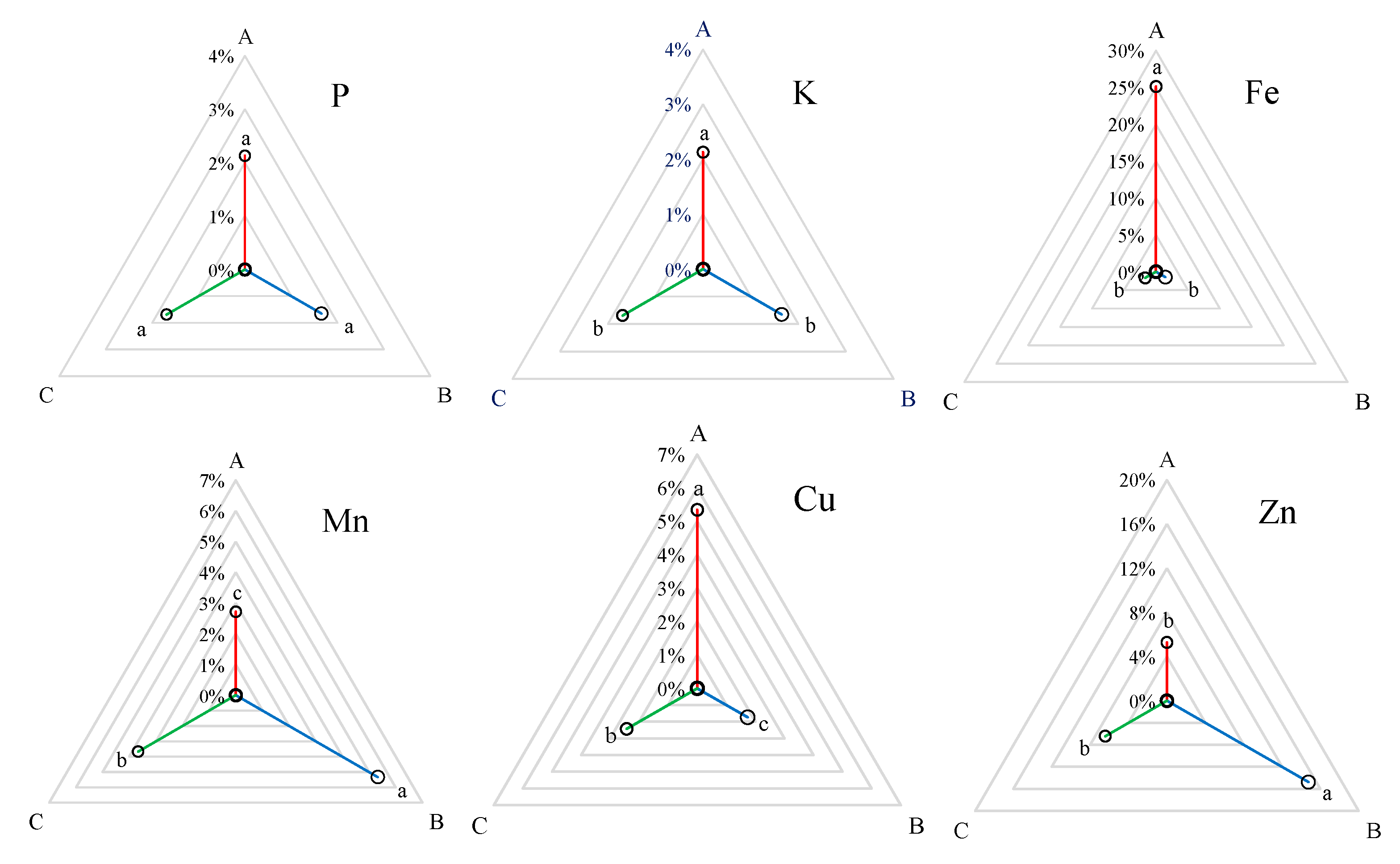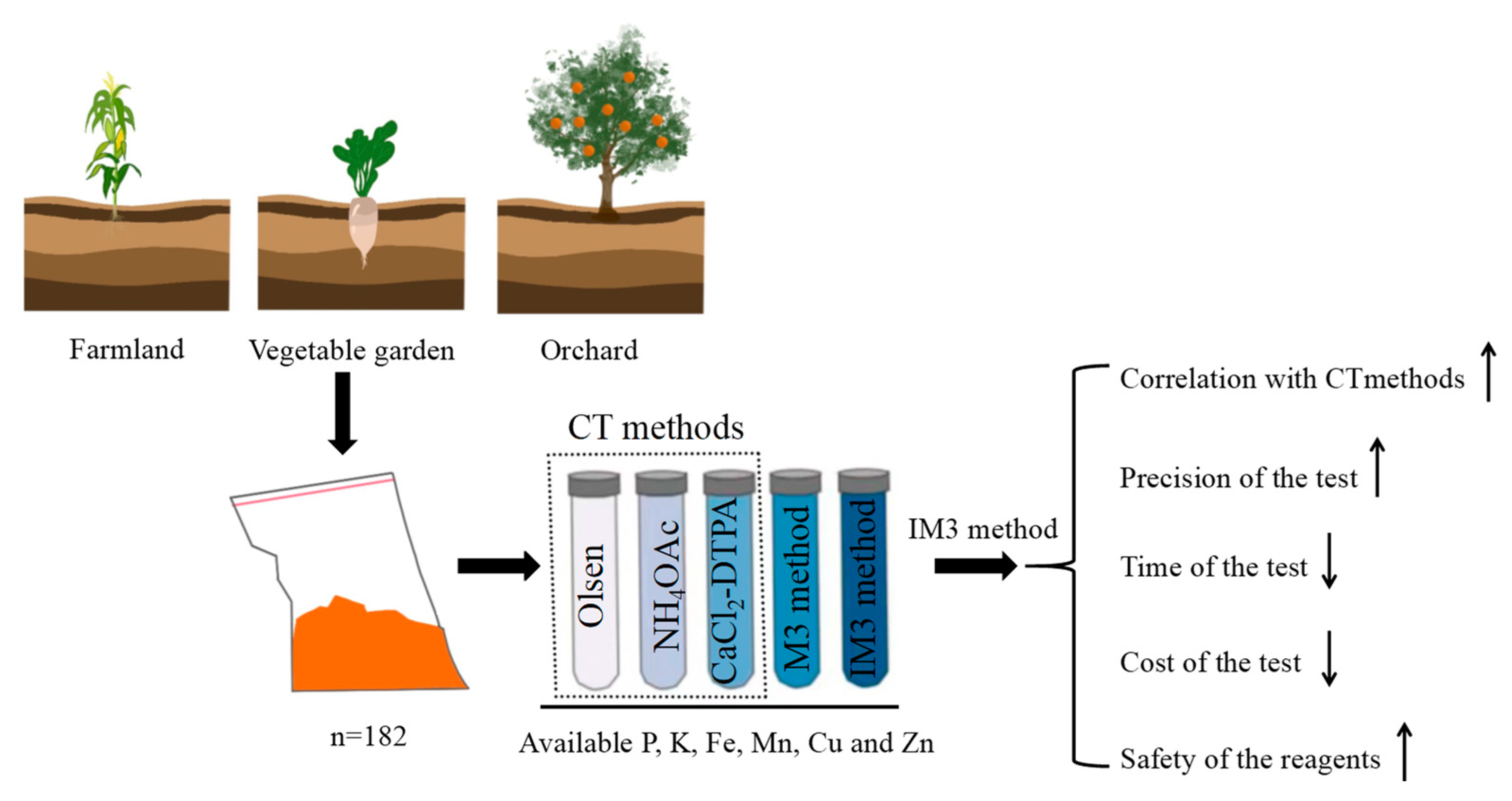Improving the Extraction Process of Mehlich 3 Method for Calcareous Soil Nutrients
Abstract
1. Introduction
2. Materials and Methods
2.1. Soil Sampling and Characterization
2.2. Experimental Design
2.2.1. Improvement of Extractant in M3 Method
2.2.2. Comparison of Testing Precision of Three Methods
2.2.3. Comparison of Testing Time and Testing Cost of Three Methods
2.3. Statistical Analysis
3. Results
3.1. Correlation Analysis of Three Test Methods
3.2. Testing Precision Analysis of Three Test Methods
3.3. Testing Time Analysis of Three Test Methods
3.4. Testing Cost Analysis of Three Test Methods
4. Discussion
4.1. Analysis of Extracting Principle of Improved IM3 Method
4.2. Feasibility Analysis of IM3 Method
5. Conclusions
Author Contributions
Funding
Institutional Review Board Statement
Informed Consent Statement
Data Availability Statement
Conflicts of Interest
References
- Shen, J.B.; Zhu, Q.C.; Jiao, X.Q.; Ying, H.; Wang, H.L.; Wen, X.; Xu, W.; Li, T.Y.; Cong, W.F.; Liu, X.J.; et al. Agriculture green development: A model for China and the world. Front. Agric. Sci. Eng. 2020, 7, 5–13. [Google Scholar] [CrossRef]
- Guo, Y.X.; Chen, Y.F.; Searchinger, T.D.; Zhou, M.; Pan, D.; Yang, J.N.; Wu, L.; Cui, Z.L.; Zhang, W.F.; Zhang, F.S.; et al. Air quality, nitrogen use efficiency and food security in China are improved by cost-effective agricultural nitrogen management. Nat. Food 2020, 1, 648–658. [Google Scholar] [CrossRef]
- Zhang, X.; Davidson, E.A.; Mauzerall, D.L.; Searchinger, T.D.; Dumas, P.; Shen, Y. Managing nitrogen for sustainable development. Nature 2015, 528, 51–59. [Google Scholar] [CrossRef] [PubMed]
- Li, F.; Xiang, M.T.; Liu, S.Y.; Lei, K.G.; Shi, Z.; Yang, J.Y.; Li, Y. Life cycle assessment and fertilization scheme optimization of paddy field crops in South China. J. Clean. Prod. 2021, 325, 129339. [Google Scholar] [CrossRef]
- Yu, W.Z.; Luo, X.F. Farming experience and farmers’ adoption of low-carbon management practices: The case of soil testing and fertilizer recommendations in China. Environ. Sci. Pollut. Res. Int. 2021, 29, 6755–6765. [Google Scholar] [CrossRef] [PubMed]
- Takrattanasaran, N.; Chanchareonsook, J.; Thongpae, S.; Sarobol, E. Evaluation of Mehlich3 and ammonium bicarbonate-DTPA extractants for prediction of available zinc in calcareous soils in central thailand. Kasetsart J.—Nat. Sci. 2010, 44, 824–829. [Google Scholar]
- Olsen, S.R. Estimation of Available Phosphorus in Soils by Extraction with Sodium Bicarbonate; Miscellaneous Paper Institute for Agricultural Research Samaru: Samaru, Nigeria, 1954. [Google Scholar]
- Jackson, M.L. Soil Chemical Analysis; Verlag, Prentice Hall: Hoboken, NJ, USA, 1958; Volume 288. [Google Scholar]
- Lindsay, W.L.; Norvell, W.A. Development of a DTPA soil test for zinc, iron, manganese, and copper. Soil Sci. Soc. Am. J. 1978, 42, 421–428. [Google Scholar] [CrossRef]
- He, D.X.; Bai, Y.L.; Lu, S.K.; Tian, S. Effects of fresh soil samples and modified ASI extractant on soil available nutrient determination. Plant Nutr. Fertil. Sci. 2011, 17, 486–493. [Google Scholar]
- Ferrando, M.G.; Barbazan, M.M.; Garcia, F.O.; Mallarino, A.P. Comparison of the ammonium acetate, Mehlich3, and sodium tetraphenylboron as extractants to evaluate crop available potassium. Commun. Soil Sci. Plant Anal. 2020, 51, 997–1005. [Google Scholar] [CrossRef]
- Kulhánek, M.; Ern, J.; Balík, J.; Sedlá, O.; Suran, P. Potential of Mehlich3 method for extracting plant available sulfur in the Czech agricultural soils. Plant Soil Environ. 2018, 64, 455–462. [Google Scholar]
- Seth, A.; Sarkar, D.; Masto, R.E.; Batabyal, K.; Mandal, B. Critical limits of Mehlich3 extractable phosphorous, potassium, sulfur, boron and Zn in soils for nutrition of rice (Oryza sativa L.). J. Soil Sci. Plant Nutr. 2018, 18, 512–523. [Google Scholar]
- Xiong, G.Y.; Liu, D.B.; Chen, F.; Zheng, X.H.; Yuan, J.F.; Zhao, S.J.; Fan, X.P.; Zhang, J.M.; Hu, X.Y. Study on the correlation of ASI and China routine method for soil available P, K and N determination. Soil Fertil. Sci. China 2007, 3, 73–76. [Google Scholar]
- Cui, J.Y.; Song, J.L.; Xue, H.Y.; Xia, X.P.; Jiang, R.F. Research of Mehlich3-ICP for soil available P. Chin. J. Soil Sci. 2011, 42, 388–392. [Google Scholar]
- Huang, X.; Du, L.; Hong, J.; Chen, G.; Wang, S.P.; Lian, Z.C.; Zhang, G.Y.; Jiang, L.; Zhang, L.H.; Ye, L.X. Study on the correlation between potassium dichromate external heating method and ASI for soil organic matter determination. Hubei Agric. Sci. 2020, 59, 122–125. [Google Scholar]
- Wang, Y. Soil nutrient testing method and its evaluation. Estate Sci. Trib. 2013, 12, 88–90. [Google Scholar]
- Zhang, C.P.; Niu, D.C.; Ren, Y.T.; Fu, H. Extractability of nutrients using Mehlich 3 and ammonium bicarbonate-DTPA methods for selected grassland soils of China. Plant Soil Environ. 2018, 64, 448–454. [Google Scholar]
- IUSS Working Group WRB. World Reference Base for Soil Resources 2014. International Soil Classification System for Naming Soils and Creating Legends for Soil Maps. Update 2015; World Soil Resources Report 106; FAO: Rome, Italy, 2015; p. 188. [Google Scholar]
- KulháneK, M.; BalíK, J.; Černý, J.; Vašák, F.; Shejbalová, Š. Influence of long-term fertilizer application on changes of the content of Mehlich-3 estimated soil macronutrients. Plant Soil Environ. 2014, 60, 151–157. [Google Scholar] [CrossRef]
- Seth, A.; Sarkar, D.; Datta, A.; Mandal, B.; Chowdhury, A.; Masto, R.E.; Chakravarty, A.K.; Hazra, G.C.; Badole, S.; Batyabal, K.; et al. Suitability of complex extractants for assessment of available soil zinc for nutrition of rice (Oryza sativa L.) in subtropical India. Soil Sci. 2017, 182, 28–35. [Google Scholar] [CrossRef]
- Mattila, T.J.; Ezzati, G. A common agricultural soil test can identify legacy P hotspots in a drainage ditch network. J. Environ. Manag. 2022, 302, 113876. [Google Scholar] [CrossRef]
- Khan, A.; Lu, G.Y.; Zhang, H.T.; Wang, R.J.; Lv, F.L.; Xu, J.X.; Yang, X.Y.; Zhang, S.L. Land use changes impact distribution of phosphorus in deep soil profile. J. Soil Sci. Plant Nutr. 2019, 19, 565–573. [Google Scholar] [CrossRef]
- Du, S.; Gao, X.Z. National Agricultural Technology Extension and Service Center: Soil Analysis and Technical Specifications; China Agriculture Press: Beijing, China, 2006. [Google Scholar]
- Ran, J.W.; Zhang, X.; Ning, P.; Sun, X.; Zhang, Y.X.; Jin, Y. The correlation between the forms of iron and the properties of soils in China. Environ. Sci. Surv. 2017, 36, 1–4. [Google Scholar]
- Bao, S.D. Soil Agro-Chemistrical Analysis; China Agriculture Press: Beijing, China, 2000. [Google Scholar]
- Elrashidi, M.A.; Mays, M.D.; Lee, C.W. Assessment of Mehlich3 and ammonium bicarbonate-DTPA extraction for simultaneous measurement of fifteen elements in soils. Commun. Soil Sci. Plant Anal. 2003, 34, 2817–2838. [Google Scholar] [CrossRef]
- Han, X.Y. Correlation study on testing available nutrient in calcareous soil by using Mehlich3 method. J. China Agric. Univ. 2009, 14, 104–110. [Google Scholar]





| Soil | n | pH | Organic Matter (g/kg) | Available P (mg/kg) | Available K (mg/kg) | Available Fe (mg/kg) | Available Mn (mg/kg) | Available Cu (mg/kg) | Available Zn (mg/kg) |
|---|---|---|---|---|---|---|---|---|---|
| Standard sample | 1 | 8.0 | - | 36 | 217 | 50 | 25 | 1.9 | 1.8 |
| Farmland | 52 | 7.5–8.6 | 3.7–18.5 | 0.1–47.1 | 69.6–181 | 3.5–17.3 | 1.1–7.1 | 0.4–8.6 | 0.3–9.8 |
| Vegetable | 69 | 7.2–8.2 | 11.4–39.2 | 0.9–215 | 31.3–271 | 7.9–26.3 | 2.4–8.3 | 0.8–12.3 | 1.4–11.0 |
| Orchard | 61 | 7.4–8.3 | 7.3–20.7 | 3.6–322 | 56.7–660 | 8.9–28.7 | 3.3–9.0 | 1.6–12.0 | 2.5–11.4 |
| Methods | Determination | Composition of Extractant | pH | Soil:Solution |
|---|---|---|---|---|
| CT | Available P | NaHCO3 | 8.5 | 1:20 |
| Available K | NH4OAc | 7.0 | 1:10 | |
| Available Fe, Mn, Cu and Zn | DTPA, CaCl2, TEA | 7.3 | 1:2 | |
| M3 | Available P, K, Fe, Mn, Cu and Zn | EDTA, NH4F, HOAc, HNO3, NH4NO3 | 2.5 | 1:10 |
| IM3 | Available P, K, Fe, Mn, Cu and Zn | EDTA, NH4F, HOAc, NH4Cl | 3.6 | 1:10 |
| Step | CT Method (min/piece) | M3 Method (min/piece) | IM3 Method (min/piece) | ||
|---|---|---|---|---|---|
| P | K | Fe, Mn, Cu, Zn | P, K, Fe, Mn, Cu, Zn | P, K, Fe, Mn, Cu, Zn | |
| Extractant preparation | 1.5 | 1 | 2 | 3 | 2.8 |
| Soil weighing | 1 | 1 | 1 | 1 | 1 |
| Extractant adding | 1 | 1 | 1 | 1 | 1 |
| Oscillating and filtering | 2.5 | 2.5 | 6 | 1.5 | 1.5 |
| Total | 21.5 | 6.5 | 6.3 | ||
| Methods (yuan/piece) | Reagent | Filter Paper | Total | ||||
|---|---|---|---|---|---|---|---|
| P | K | Fe, Mn, Cu, Zn | P | K | Fe, Mn, Cu, Zn | ||
| CT | 1.48 | 0.27 | 0.2 | 0.33 | 0.33 | 0.33 | 2.94 |
| M3 | 1.21 | 0.33 | 1.54 | ||||
| IM3 | 0.81 | 0.33 | 1.14 | ||||
Publisher’s Note: MDPI stays neutral with regard to jurisdictional claims in published maps and institutional affiliations. |
© 2022 by the authors. Licensee MDPI, Basel, Switzerland. This article is an open access article distributed under the terms and conditions of the Creative Commons Attribution (CC BY) license (https://creativecommons.org/licenses/by/4.0/).
Share and Cite
Li, C.; Wang, S.; Sun, M.; Li, D.; Xu, H.; Zhang, L.; Xue, C.; Ma, W.; Sun, Z. Improving the Extraction Process of Mehlich 3 Method for Calcareous Soil Nutrients. Agronomy 2022, 12, 2907. https://doi.org/10.3390/agronomy12112907
Li C, Wang S, Sun M, Li D, Xu H, Zhang L, Xue C, Ma W, Sun Z. Improving the Extraction Process of Mehlich 3 Method for Calcareous Soil Nutrients. Agronomy. 2022; 12(11):2907. https://doi.org/10.3390/agronomy12112907
Chicago/Turabian StyleLi, Changqing, Shuo Wang, Mengyu Sun, Dongxiao Li, Huasen Xu, Liangyu Zhang, Cheng Xue, Wenqi Ma, and Zhimei Sun. 2022. "Improving the Extraction Process of Mehlich 3 Method for Calcareous Soil Nutrients" Agronomy 12, no. 11: 2907. https://doi.org/10.3390/agronomy12112907
APA StyleLi, C., Wang, S., Sun, M., Li, D., Xu, H., Zhang, L., Xue, C., Ma, W., & Sun, Z. (2022). Improving the Extraction Process of Mehlich 3 Method for Calcareous Soil Nutrients. Agronomy, 12(11), 2907. https://doi.org/10.3390/agronomy12112907






